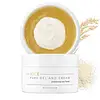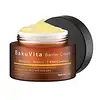What's inside
What's inside
 Key Ingredients
Key Ingredients

 Benefits
Benefits

 Concerns
Concerns

No concerns
 Ingredients Side-by-side
Ingredients Side-by-side

Water
Skin ConditioningOryza Sativa Extract
AbsorbentGlycerin
HumectantCaprylic/Capric Triglyceride
MaskingHydrogenated Polydecene
EmollientNiacinamide
SmoothingPhenyl Trimethicone
Skin ConditioningBetaine
Humectant1,2-Hexanediol
Skin ConditioningPolyglyceryl-3 Methylglucose Distearate
EmulsifyingLaminaria Japonica Extract
Skin ProtectingEclipta Prostrata Leaf Extract
Skin ConditioningCentella Asiatica Extract
CleansingFicus Carica Fruit Extract
HumectantAcmella Oleracea Extract
Skin ProtectingPhellodendron Amurense Bark Extract
Skin ConditioningMelia Azadirachta Flower Extract
Skin ConditioningMelia Azadirachta Leaf Extract
Skin ConditioningCurcuma Longa Root Extract
MaskingOcimum Sanctum Leaf Extract
Skin ConditioningTheobroma Cacao Seed Extract
AntioxidantCorallina Officinalis Extract
Skin ConditioningCamellia Sinensis Leaf Extract
AntimicrobialVigna Radiata Seed Extract
Skin ConditioningLeucojum Aestivum Bulb Extract
Skin ProtectingDiospyros Kaki Leaf Extract
Skin ProtectingMacadamia Integrifolia Seed Oil
Skin ConditioningHydrogenated Lecithin
EmulsifyingSodium Hyaluronate
HumectantCyclohexasiloxane
EmollientCetyl Alcohol
EmollientAmmonium Acryloyldimethyltaurate/Vp Copolymer
Methylpropanediol
SolventGlyceryl Polymethacrylate
Glyceryl Stearate
EmollientBehenyl Alcohol
EmollientTrehalose
HumectantPentaerythrityl Distearate
EmulsifyingPolyglyceryl-10 Laurate
Skin ConditioningOctyldodeceth-16
EmulsifyingSodium Stearoyl Glutamate
CleansingAcrylates/C10-30 Alkyl Acrylate Crosspolymer
Emulsion StabilisingGlyceryl Caprylate
EmollientFructooligosaccharides
HumectantDisodium EDTA
Cellulose Gum
Emulsion StabilisingBeta-Glucan
Skin ConditioningButylene Glycol
HumectantHydrolyzed Hyaluronic Acid
HumectantDextrin
AbsorbentCeramide NP
Skin ConditioningPentylene Glycol
Skin ConditioningEthylhexylglycerin
Skin ConditioningHydroxyacetophenone
AntioxidantWater, Oryza Sativa Extract, Glycerin, Caprylic/Capric Triglyceride, Hydrogenated Polydecene, Niacinamide, Phenyl Trimethicone, Betaine, 1,2-Hexanediol, Polyglyceryl-3 Methylglucose Distearate, Laminaria Japonica Extract, Eclipta Prostrata Leaf Extract, Centella Asiatica Extract, Ficus Carica Fruit Extract, Acmella Oleracea Extract, Phellodendron Amurense Bark Extract, Melia Azadirachta Flower Extract, Melia Azadirachta Leaf Extract, Curcuma Longa Root Extract, Ocimum Sanctum Leaf Extract, Theobroma Cacao Seed Extract, Corallina Officinalis Extract, Camellia Sinensis Leaf Extract, Vigna Radiata Seed Extract, Leucojum Aestivum Bulb Extract, Diospyros Kaki Leaf Extract, Macadamia Integrifolia Seed Oil, Hydrogenated Lecithin, Sodium Hyaluronate, Cyclohexasiloxane, Cetyl Alcohol, Ammonium Acryloyldimethyltaurate/Vp Copolymer, Methylpropanediol, Glyceryl Polymethacrylate, Glyceryl Stearate, Behenyl Alcohol, Trehalose, Pentaerythrityl Distearate, Polyglyceryl-10 Laurate, Octyldodeceth-16, Sodium Stearoyl Glutamate, Acrylates/C10-30 Alkyl Acrylate Crosspolymer, Glyceryl Caprylate, Fructooligosaccharides, Disodium EDTA, Cellulose Gum, Beta-Glucan, Butylene Glycol, Hydrolyzed Hyaluronic Acid, Dextrin, Ceramide NP, Pentylene Glycol, Ethylhexylglycerin, Hydroxyacetophenone
Water
Skin ConditioningGlycerin
Humectant1,2-Hexanediol
Skin ConditioningNiacinamide
SmoothingDicaprylyl Carbonate
EmollientCetearyl Alcohol
EmollientCetyl Ethylhexanoate
EmollientPropanediol
SolventMethyl Trimethicone
Skin ConditioningPanthenol
Skin ConditioningLaminaria Japonica Extract
Skin ProtectingEclipta Prostrata Leaf Extract
Skin ConditioningAstragalus Membranaceus Root Extract
EmollientPoria Cocos Extract
Skin ConditioningMagnolia Sieboldii Extract
Skin ConditioningMagnolia Liliflora Flower Extract
Skin ConditioningCnidium Officinale Root Extract
Skin ConditioningBenincasa Cerifera Seed Extract
Skin ConditioningPrunus Persica Kernel Extract
MoisturisingMalt Extract
Skin ProtectingElaeis Guineensis Oil
EmollientHydrogenated Lecithin
EmulsifyingBakuchiol
AntimicrobialPotassium Cetyl Phosphate
EmulsifyingAmmonium Polyacryloyldimethyl Taurate
Emulsion StabilisingHydroxyethyl Acrylate/Sodium Acryloyldimethyl Taurate Copolymer
Emulsion StabilisingCetearyl Olivate
Sorbitan Olivate
Emulsifying3-O-Ethyl Ascorbic Acid
Skin ConditioningXanthan Gum
EmulsifyingTocopherol
AntioxidantButylene Glycol
HumectantAdenosine
Skin ConditioningDisodium EDTA
Sorbitan Isostearate
EmulsifyingT-Butyl Alcohol
PerfumingFructooligosaccharides
HumectantBeta-Glucan
Skin ConditioningHydrolyzed Hyaluronic Acid
HumectantAscorbic Acid Polypeptide
AntioxidantEthylhexylglycerin
Skin ConditioningWater, Glycerin, 1,2-Hexanediol, Niacinamide, Dicaprylyl Carbonate, Cetearyl Alcohol, Cetyl Ethylhexanoate, Propanediol, Methyl Trimethicone, Panthenol, Laminaria Japonica Extract, Eclipta Prostrata Leaf Extract, Astragalus Membranaceus Root Extract, Poria Cocos Extract, Magnolia Sieboldii Extract, Magnolia Liliflora Flower Extract, Cnidium Officinale Root Extract, Benincasa Cerifera Seed Extract, Prunus Persica Kernel Extract, Malt Extract, Elaeis Guineensis Oil, Hydrogenated Lecithin, Bakuchiol, Potassium Cetyl Phosphate, Ammonium Polyacryloyldimethyl Taurate, Hydroxyethyl Acrylate/Sodium Acryloyldimethyl Taurate Copolymer, Cetearyl Olivate, Sorbitan Olivate, 3-O-Ethyl Ascorbic Acid, Xanthan Gum, Tocopherol, Butylene Glycol, Adenosine, Disodium EDTA, Sorbitan Isostearate, T-Butyl Alcohol, Fructooligosaccharides, Beta-Glucan, Hydrolyzed Hyaluronic Acid, Ascorbic Acid Polypeptide, Ethylhexylglycerin
Ingredients Explained
These ingredients are found in both products.
Ingredients higher up in an ingredient list are typically present in a larger amount.
1,2-Hexanediol is a synthetic liquid and another multi-functional powerhouse.
It is a:
- Humectant, drawing moisture into the skin
- Emollient, helping to soften skin
- Solvent, dispersing and stabilizing formulas
- Preservative booster, enhancing the antimicrobial activity of other preservatives
Beta-Glucan is a polysaccharide. It can be derived from the cell walls of seaweed, oats, yeast, and fungi. It hydrates the skin and helps boost your skin's natural barrier.
As an antioxidant, beta-glucan helps fight free-radicals. Free-radicals are molecules that may damage your skin cells, such as pollution.
Studies show this ingredient may be an effective wrinkle reducer as it can deeply penetrate into skin. It has also been show to help with wound healing.
Learn more about Beta-GlucanButylene Glycol (or BG) is used within cosmetic products for a few different reasons:
Overall, Butylene Glycol is a safe and well-rounded ingredient that works well with other ingredients.
Though this ingredient works well with most skin types, some people with sensitive skin may experience a reaction such as allergic rashes, closed comedones, or itchiness.
Learn more about Butylene GlycolDisodium EDTA plays a role in making products more stable by aiding other preservatives.
It is a chelating agent, meaning it neutralizes metal ions that may be found in a product.
Disodium EDTA is a salt of edetic acid and is found to be safe in cosmetic ingredients.
Learn more about Disodium EDTAEclipta Prostrata Leaf Extract comes from the false daisy plant. False daisy contains antioxidant compounds such as flavonoids.
One study found false daisy to absorb UVA and UVB radiation. However, this should not replace your sunscreen.
False daisy is used in both traditional medicines and foods throughout Southeast Asia and India.
Learn more about Eclipta Prostrata Leaf ExtractEthylhexylglycerin (we can't pronounce this either) is commonly used as a preservative and skin softener. It is derived from glyceryl.
You might see Ethylhexylglycerin often paired with other preservatives such as phenoxyethanol. Ethylhexylglycerin has been found to increase the effectiveness of these other preservatives.
Fructooligosaccharides is an alternative sweetener. It is often derived from the blue agave plant.
This ingredient is a prebiotic and helps to hydrate the skin. Emerging studies are also showing fructooligosaccharides to have antioxidant properties.
As a humectant, Fructooligosaccharides helps draw moisture to the skin, helping to hydrate the skin.
Bananas, onions, garlic, asparagus, jícama, and leeks also contain fructooligosaccharides.
Learn more about FructooligosaccharidesGlycerin is already naturally found in your skin. It helps moisturize and protect your skin.
A study from 2016 found glycerin to be more effective as a humectant than AHAs and hyaluronic acid.
As a humectant, it helps the skin stay hydrated by pulling moisture to your skin. The low molecular weight of glycerin allows it to pull moisture into the deeper layers of your skin.
Hydrated skin improves your skin barrier; Your skin barrier helps protect against irritants and bacteria.
Glycerin has also been found to have antimicrobial and antiviral properties. Due to these properties, glycerin is often used in wound and burn treatments.
In cosmetics, glycerin is usually derived from plants such as soybean or palm. However, it can also be sourced from animals, such as tallow or animal fat.
This ingredient is organic, colorless, odorless, and non-toxic.
Glycerin is the name for this ingredient in American English. British English uses Glycerol/Glycerine.
Learn more about GlycerinHydrogenated Lecithin is created from the hydrogenation of lecithin (a group of phospholipids). Hydrogenation is a chemical reaction between hydrogen and another element.
This ingredient is an emollient and emulsifier. As an emollient, it helps soften skin by trapping moisture within. As an emulsifier, it prevents oil and water ingredients from separating.
Hydrolyzed Hyaluronic Acid is a form of hyaluronic acid. It is created by the hydrolysis of hyaluronic acid with a high molecular weight. Once created, Hydrolyzed Hyaluronic Acid has a low molecular weight.
Low molecular weight HA has been shown to hydrate and increase elasticity of the skin. Increasing elasticity is also associated with reduction of wrinkle depth.
One study found topical low molecular weight hyaluronic acid may be considered for the treatment of rosacea in the adult population. However, we always recommend speaking with a professional about your skin concerns.
Hyaluronic acids are a humectant. This means they draw moisture from the air. Hyaluronic acids help moisturize, soothe, and protect the skin.
Read more about other common forms of hyaluronic acid:
Learn more about Hydrolyzed Hyaluronic AcidLaminaria Japonica Extract comes from a kelp more commonly known as 'sweet kelp'. It is commonly eaten in Japan, Korea, and China.
Sweet kelp is a humectant and helps hydrate your skin. Humectants draw moisture from the air to your skin.
Studies show Laminaria Japonica has antioxidant compounds. Antioxidants may help with anti-aging. Kelp also contains magnesium and zinc, making it great for calming inflammation and redness.
Learn more about Laminaria Japonica ExtractNiacinamide is a multitasking form of vitamin B3 that strengthens the skin barrier, reduces pores and dark spots, regulates oil, and improves signs of aging.
And the best part? It's gentle and well-tolerated by most skin types, including sensitive and reactive skin.
You might have heard of "niacin flush", or the reddening of skin that causes itchiness. Niacinamide has not been found to cause this.
In very rare cases, some individuals may not be able to tolerate niacinamide at all or experience an allergic reaction to it.
If you are experiencing flaking, irritation, and dryness with this ingredient, be sure to double check all your products as this ingredient can be found in all categories of skincare.
When incorporating niacinamide into your routine, look out for concentration amounts. Typically, 5% niacinamide provides benefits such as fading dark spots. However, if you have sensitive skin, it is better to begin with a smaller concentration.
When you apply niacinamide to your skin, your body converts it into nicotinamide adenine dinucleotide (NAD). NAD is an essential coenzyme that is already found in your cells as "fuel" and powers countless biological processes.
In your skin, NAD helps repair cell damage, produce new healthy cells, support collagen production, strengthen the skin barrier, and fight environmental stressors (like UV and pollution).
Our natural NAD levels start to decline with age, leading to slower skin repair, visible aging, and a weaker skin barrier. By providing your skin niacinamide, you're recharging your skin's NAD levels. This leads to stronger, healthier, and younger looking skin.
Another name for vitamin B3 is nicotinamide. This vitamin is water-soluble and our bodies don't store it. We obtain Vitamin B3 from either food or skincare. Meat, fish, wheat, yeast, and leafy greens contain vitamin B3.
The type of niacinamide used in skincare is synthetically created.
Learn more about NiacinamideWater. It's the most common cosmetic ingredient of all. You'll usually see it at the top of ingredient lists, meaning that it makes up the largest part of the product.
So why is it so popular? Water most often acts as a solvent - this means that it helps dissolve other ingredients into the formulation.
You'll also recognize water as that liquid we all need to stay alive. If you see this, drink a glass of water. Stay hydrated!
Learn more about Water